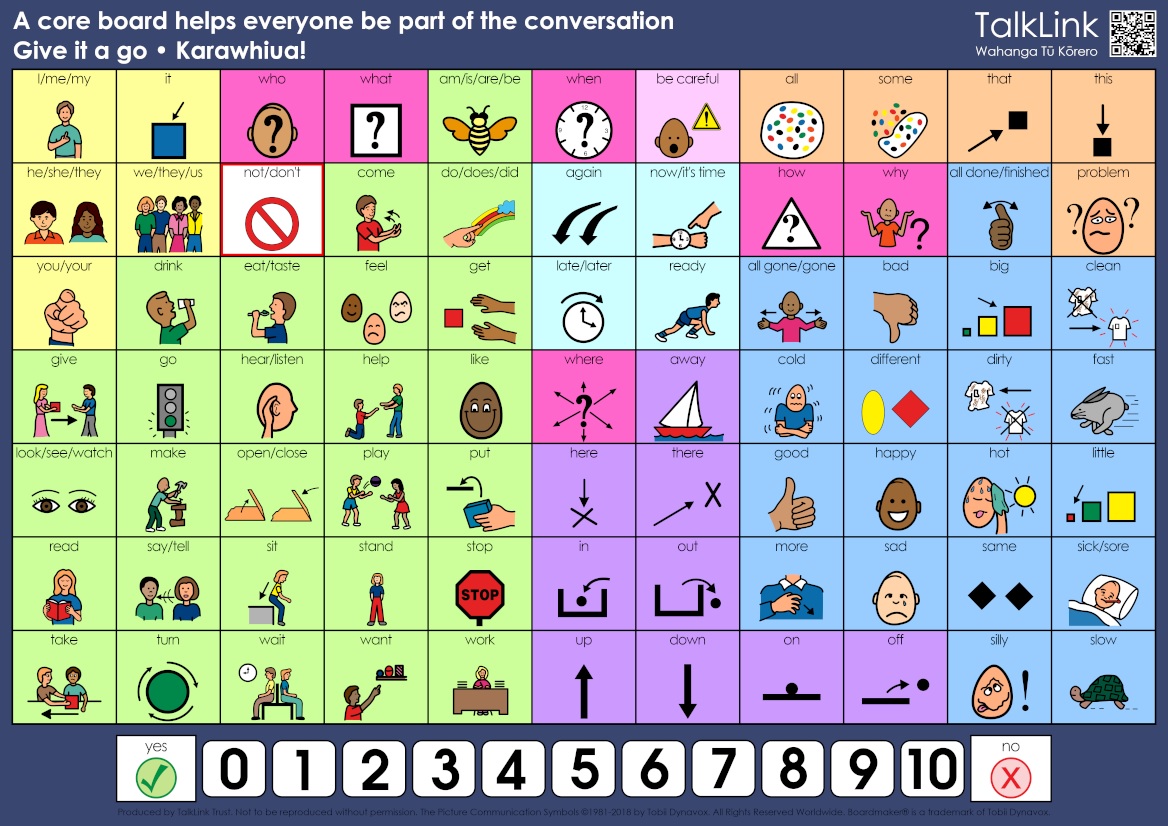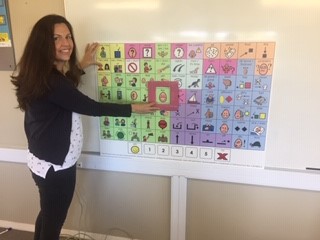Core Boards

Lots of classrooms and environments around NZ have started using large wall size core boards to support their communications in the classrooms. These are a great tool to increase the modelling that students are exposed to as well as helping language to be visual which has benefits for so many students with communication needs. Teachers are also finding them a great resource for shared reading times where students can come and engage with the story using core words on the board to retell, comment or answer a question about the story they are listening to.

Experiences of Others
This article, written by two special educators, Amy Devin and Lauren Pawlowski was posted in March 2016 on the practical AAC website. www.praacticalaac.org/praactical/praactical-teaching-in-an-asd-classroom-bigger-is-better-with-core-vocabulary
It has some great advice for teachers who have students with complex communication needs in their classrooms who would benefit from lots of aided language input or modelling the use of core vocabulary.
Opportunities Throughout the Day
By having a large core board in your classroom, you are increasing the chances of having AAC available within arm’s reach at all times. The more your students see you ‘speak AAC’ the more likely they will be to learn and extend their use of AAC using their own systems.
There are so many ways that you can use a large core board to model throughout the day. Below are a few ideas but these are by no means the only ones! Don’t limit yourself to using the board during whole group ‘circle time’ sessions.
· Morning Circle/Meetings - use your board to model making comments, asking questions and giving compliments.
· You and your teacher aides could share some news from their weekend using the core board.
· Transitions – Give directions using the board. Can some of your students take a turn to give the directions too?
· Shared Reading - Use your board during shared reading to talk about the pictures and text in the book.
· Shared Writing - You can model talking about an experience or picture during shared writing using your core board. Have your alternative pencil ready to model as well!
· Maths - Talk about concepts in a whole class maths lesson using your core board.
· Playtime - If your board is portable enough, you can take it outside for playtime. Students may want to ask for help or take turns with a friend using that language.
· Mealtimes – What a great time for conversation! Model talking about what you like to eat, what tastes good/bad. Chat about what we might do at playtime.
· Choosing – Your students will have multiple opportunities to make choices throughout the day. Can they use the core board to make requests and take turns?
· Games – Give your students the chance to be in charge of games by using words like ‘stop, Go, your turn, My turn, Uh-oh! and Silly!’

Lots of classrooms and environments around NZ have started using large wall size core boards to support their communications in the classrooms. These are a great tool to increase the modelling that students are exposed to as well as helping language to be visual which has benefits for so many students with communication needs. Teachers are also finding them a great resource for shared reading times where students can come and engage with the story using core words on the board to retell, comment or answer a question about the story they are listening to.

Experiences of Others
This article, written by two special educators, Amy Devin and Lauren Pawlowski was posted in March 2016 on the practical AAC website. www.praacticalaac.org/praactical/praactical-teaching-in-an-asd-classroom-bigger-is-better-with-core-vocabulary
It has some great advice for teachers who have students with complex communication needs in their classrooms who would benefit from lots of aided language input or modelling the use of core vocabulary.
Opportunities Throughout the Day
By having a large core board in your classroom, you are increasing the chances of having AAC available within arm’s reach at all times. The more your students see you ‘speak AAC’ the more likely they will be to learn and extend their use of AAC using their own systems.
There are so many ways that you can use a large core board to model throughout the day. Below are a few ideas but these are by no means the only ones! Don’t limit yourself to using the board during whole group ‘circle time’ sessions.
· Morning Circle/Meetings - use your board to model making comments, asking questions and giving compliments.
· You and your teacher aides could share some news from their weekend using the core board.
· Transitions – Give directions using the board. Can some of your students take a turn to give the directions too?
· Shared Reading - Use your board during shared reading to talk about the pictures and text in the book.
· Shared Writing - You can model talking about an experience or picture during shared writing using your core board. Have your alternative pencil ready to model as well!
· Maths - Talk about concepts in a whole class maths lesson using your core board.
· Playtime - If your board is portable enough, you can take it outside for playtime. Students may want to ask for help or take turns with a friend using that language.
· Mealtimes – What a great time for conversation! Model talking about what you like to eat, what tastes good/bad. Chat about what we might do at playtime.
· Choosing – Your students will have multiple opportunities to make choices throughout the day. Can they use the core board to make requests and take turns?
· Games – Give your students the chance to be in charge of games by using words like ‘stop, Go, your turn, My turn, Uh-oh! and Silly!’
